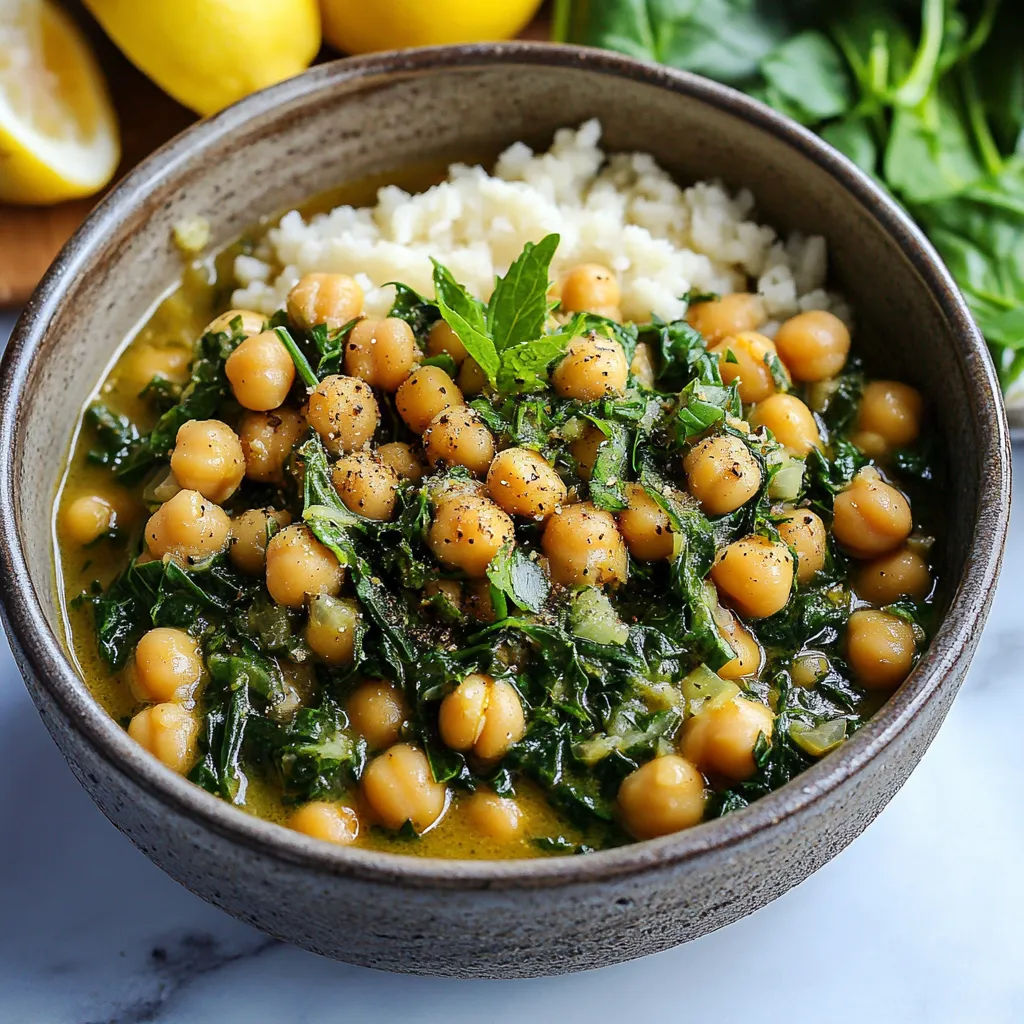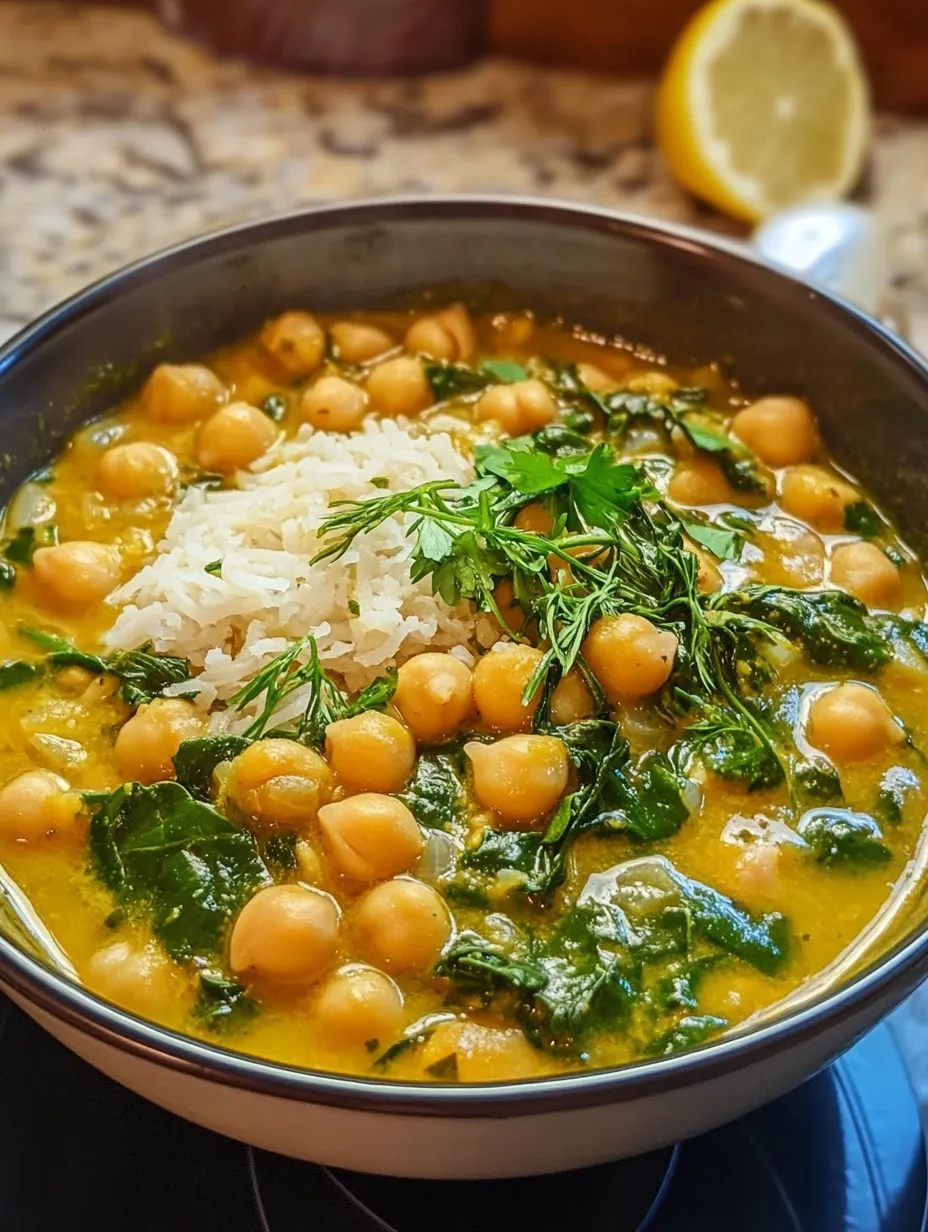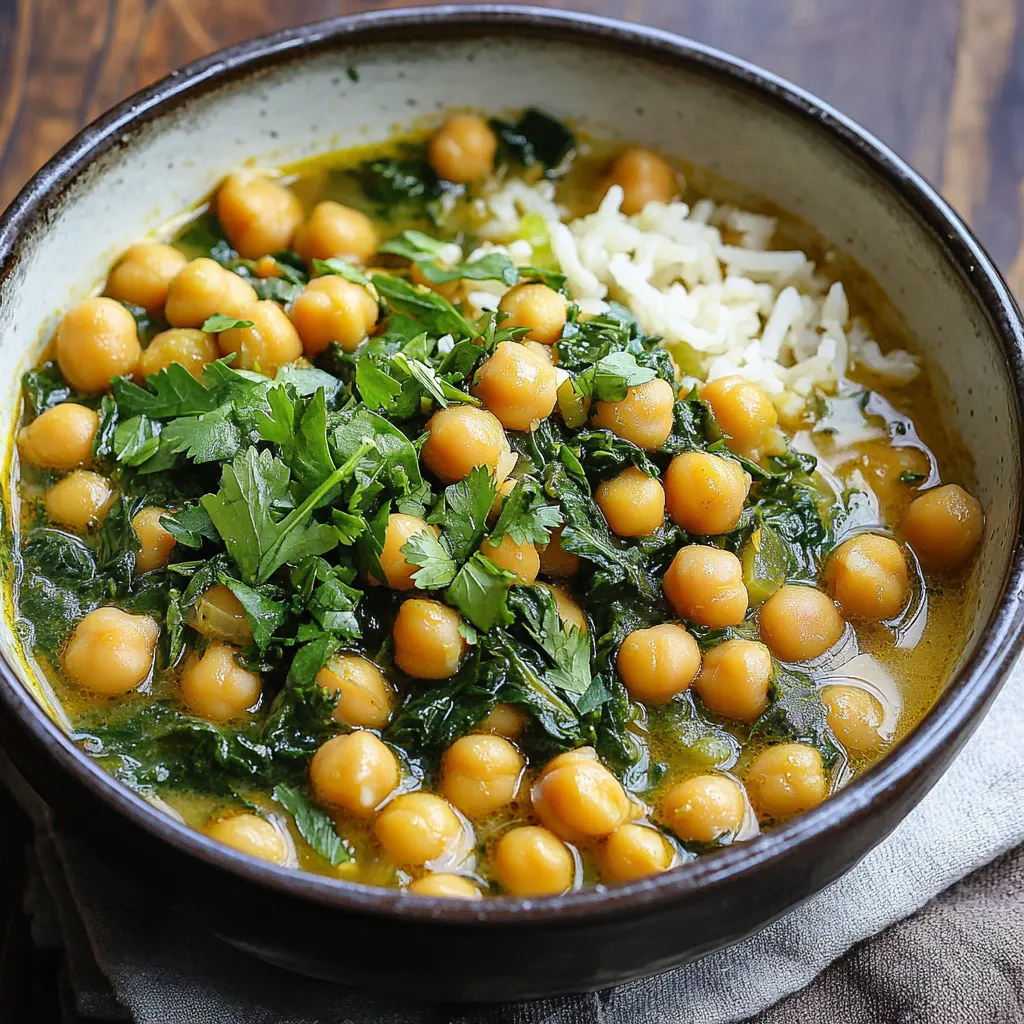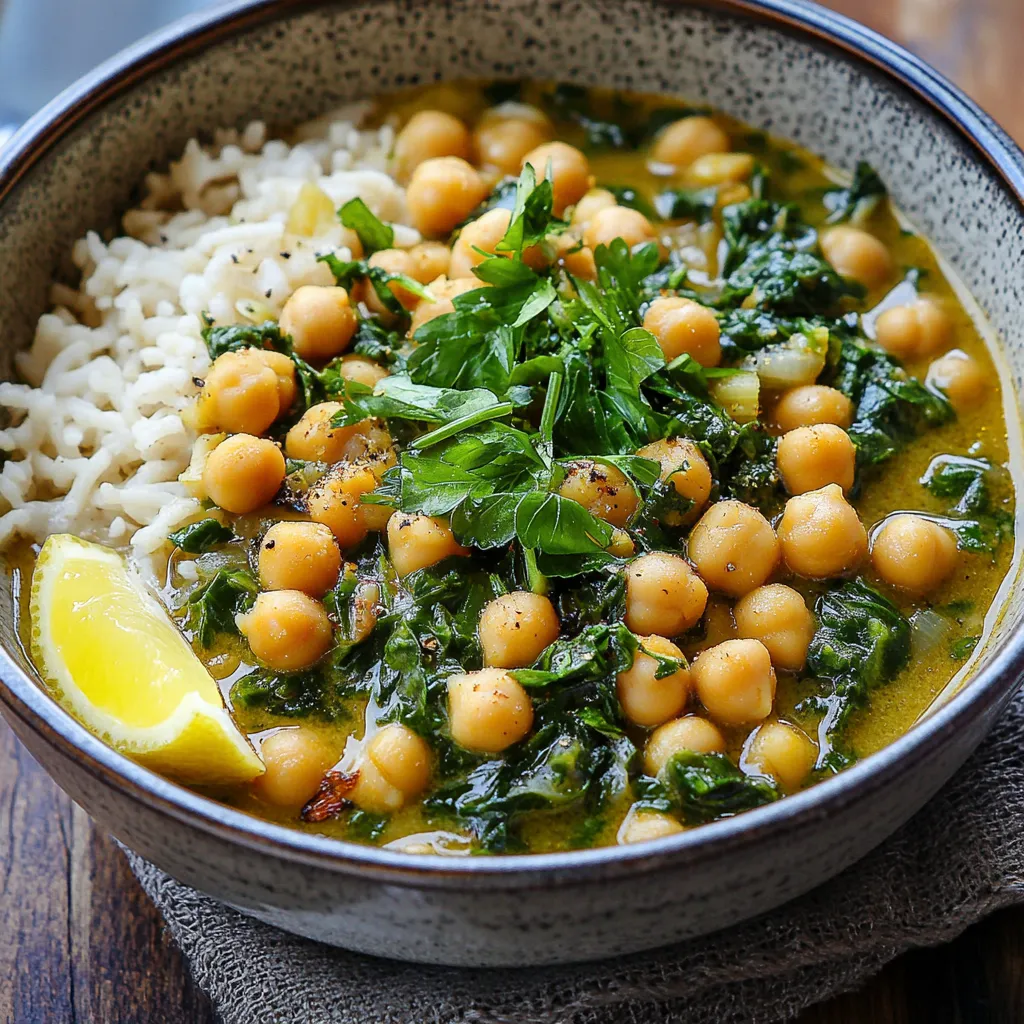 Pin it
Pin it
Golden chickpeas swimming in a fragrant broth alongside wilted spinach and a garden's worth of fresh herbs create a stew that's both comforting and bright. This Mediterranean-inspired dish transforms humble ingredients into a satisfying meal that fills your kitchen with the aroma of fresh herbs and warm spices.
I first made this stew on a chilly autumn evening when I needed something quick but nourishing. Now it's become a family favorite, with my kids surprisingly loving the "green soup" as they call it. The secret, I've found, is letting each herb shine while creating a harmonious blend.
Essential Ingredients Guide
- Fresh herbs: Look for bright, perky leaves without any yellowing. I keep my herbs fresh by storing them upright in jars with a bit of water, like a bouquet
- Chickpeas: While canned are convenient, choose low-sodium varieties and rinse thoroughly. The texture should be firm but creamy
- Spinach: Baby spinach offers the most delicate texture, but mature leaves work too - just remove any tough stems
- Lemon: Use organic when possible since we're using both juice and zest. A room-temperature lemon yields more juice
- Garlic: Choose firm, heavy heads with tight skin. Pre-minced garlic won't give you the same depth of flavor
 Pin it
Pin it
Detailed Cooking Instructions
- Building the Flavor Base:
- Heat your pan before adding oil - it should shimmer but not smoke. Take time with the onions - they should become translucent and slightly golden for the best flavor. Add garlic just briefly to prevent burning while releasing its essential oils. Toast the turmeric in the oil to bloom its flavors before adding liquid.
- Creating the Perfect Broth:
- Add broth gradually while stirring to prevent lumping. Keep heat at a gentle simmer - violent bubbling can break down the chickpeas. Taste and adjust seasoning gradually throughout cooking. Allow time for the flavors to meld before adding herbs.
- Incorporating Greens and Herbs:
- Add heartier greens like kale earlier if using instead of spinach. Chop herbs just before adding to preserve their oils. Stir gently to prevent bruising the herbs. Add lemon juice at the very end to maintain brightness.
 Pin it
Pin it
My grandmother always said good soup needs time to "whisper to itself." While this stew is quick-cooking, letting it rest for 5-10 minutes before serving allows the flavors to settle and deepen. I've learned that patience here makes all the difference.
This stew has become my go-to recipe for both casual family dinners and when entertaining vegetarian friends. Its simplicity belies its complex flavors, and the way it fills the house with warming aromas makes any day feel special. Remember, cooking is about trusting your instincts - taste as you go and adjust the seasonings to make it your own.
Making It Your Own
The beauty of this stew lies in its adaptability. Through countless iterations in my kitchen, I've discovered some winning combinations:
- Replace chickpeas with white beans for a creamier texture
- Add roasted butternut squash cubes for natural sweetness
- Stir in coconut milk for a richer broth
One rainy afternoon, I added some leftover roasted eggplant, and it transformed the stew into something reminiscent of Middle Eastern cuisine. These happy accidents often lead to the best variations.
Perfect Pairings
Serve over warm, fluffy quinoa to soak up the flavorful broth
Pair with crusty sourdough bread for dipping
Add a dollop of Greek yogurt swirled with za'atar
Storage and Reheating Magic
I've found this stew actually improves over time. Store it properly, and you'll have wonderful meals throughout the week:
- Cool completely before refrigerating
- Store herbs and greens separately if meal prepping
- Add a splash of fresh lemon juice when reheating
- Thin with warm broth if needed
Seasonal Adaptations
Spring: Add fresh peas and tender asparagus tips
Summer: Stir in cherry tomatoes and fresh corn
Fall: Include diced sweet potatoes and sage
Winter: Mix in roasted root vegetables and extra spices
Growing up, my mother always said soup was medicine for the soul. This stew proves her right - it's both nourishing and comforting, perfect for days when you need a gentle boost of energy and warmth.
The Art of Building Layers
Through years of making this stew, I've discovered that layering flavors creates more depth:
- Start with a golden-brown onion base - don't rush this step
- Let spices bloom in the oil for 30 seconds
- Add aromatics in stages rather than all at once
My Italian neighbor taught me to save parmesan rinds in the freezer specifically for soups and stews like this. Adding one while simmering gives an unexpected umami boost.
Pressure Cooker Adaptation
For busy weeknights, I've perfected a pressure cooker version:
- Use sauté function for aromatics
- Add ingredients except herbs and spinach
- Cook at high pressure for 10 minutes
- Quick release and stir in greens and herbs
Freezing Tips for Perfect Meal Prep
Freeze in individual portions for easy reheating
Leave out fresh herbs - add them after reheating
Cool completely before freezing to prevent ice crystals
Label with date and reheating instructions
I learned the hard way that proper labeling saves confusion - my husband once reheated this thinking it was curry!
Creating a Complete Meal
The stew can become a feast with thoughtful sides:
Serve alongside warm pita and olive tapenade
Add a crisp cucumber salad with mint
Include pickled vegetables for brightness
Global Flavor Variations
Mediterranean: Add olives and crumbled feta
Indian: Stir in garam masala and finish with coconut milk
Moroccan: Include preserved lemon and harissa
One evening, while hosting friends from different cultures, we created a "stew bar" with various toppings and spices, letting everyone customize their bowl. It became a wonderful way to share stories and traditions.
 Pin it
Pin it
Expert Tips for Success
Reserve some chickpea liquid to adjust consistency
Toast nuts for garnish in a dry pan until fragrant
Keep fresh herbs in stem-side water like flowers
My grandmother always said that a good stew should "tell a story in every spoonful." This recipe does just that - it speaks of Mediterranean gardens, warming spices, and the comfort of home-cooked meals. Remember, cooking is a journey of discovery, and each time you make this stew, you'll find new ways to make it your own.
This humble stew has become more than just a recipe in my kitchen - it's a template for creating nourishing meals that adapt to the seasons and what's on hand. The key is to approach it with creativity and trust your instincts. Whether you're making it for a quiet dinner at home or sharing with friends, it's a dish that never fails to bring comfort and satisfaction to the table. Remember, the best cooking comes from the heart, and this stew is a perfect canvas for expressing your culinary creativity.
Frequently Asked Questions
- → Can I make this vegetarian?
- Yes, simply use vegetable broth instead of chicken broth for a completely vegetarian version.
- → What other greens can I use?
- Kale or swiss chard work well. If using kale, massage it first to make it more tender.
- → Can I make this ahead?
- Yes, this stew keeps well and can be made ahead. The flavors often improve the next day.
- → How can I adjust the spiciness?
- The cayenne is optional - you can omit it entirely or adjust the amount to your taste preference.
- → What can I serve with this stew?
- It's delicious on its own or served over rice. You can also add a dollop of plain yogurt for extra creaminess.
